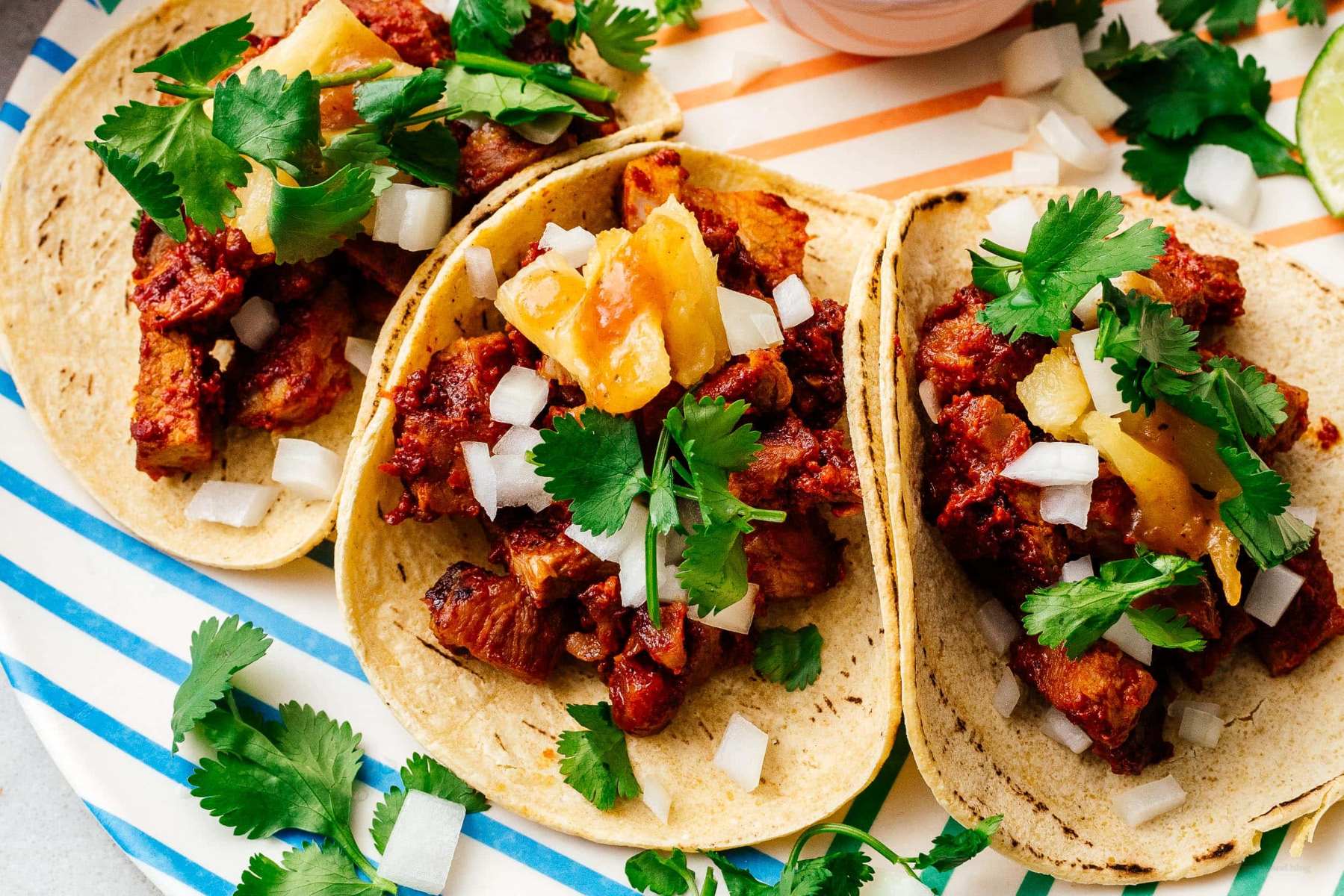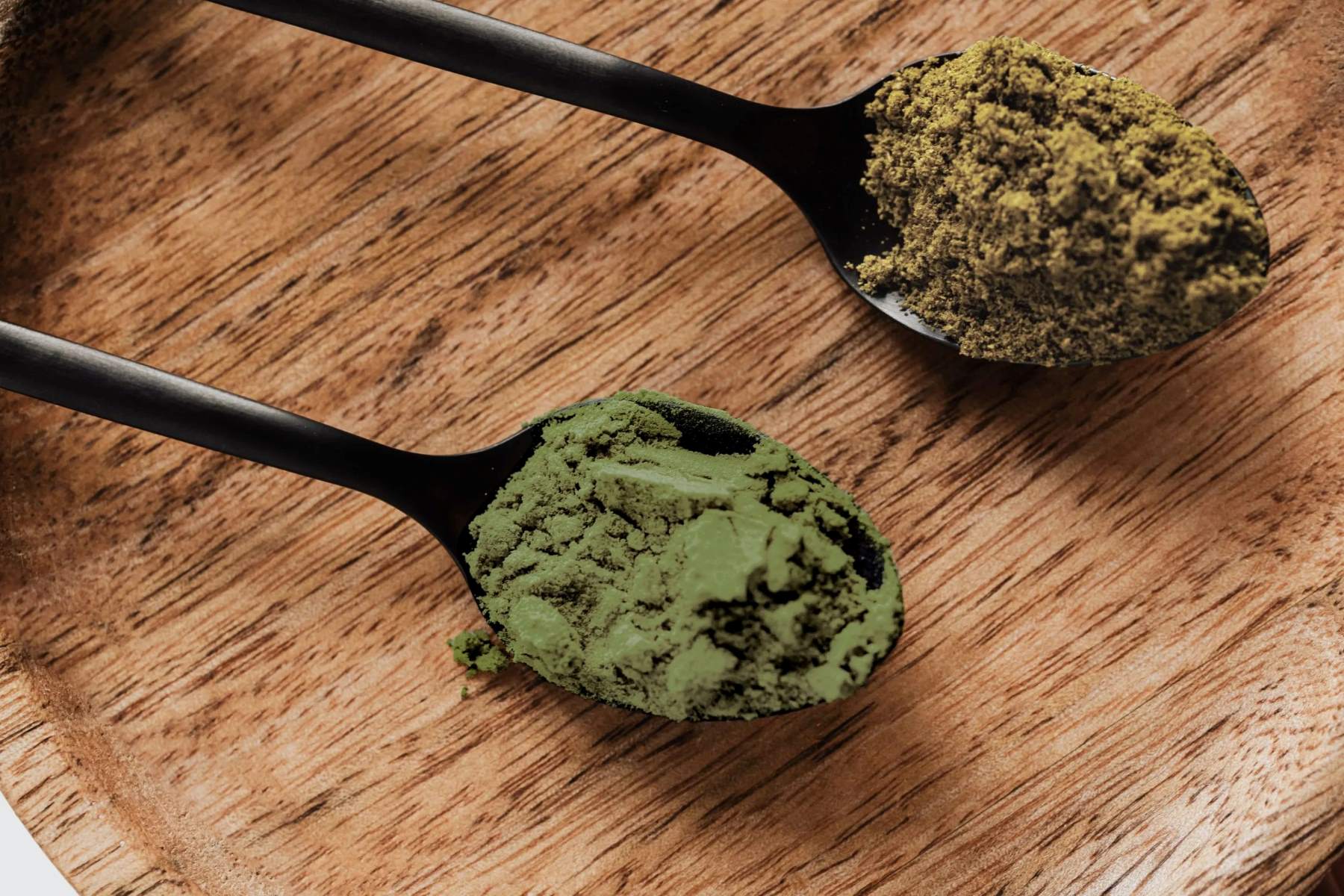Home>Food and Cooking>The Ultimate Guide To Understanding Carnitas And Al Pastor: Unveiling The Delicious Differences


Food and Cooking
The Ultimate Guide To Understanding Carnitas And Al Pastor: Unveiling The Delicious Differences
Published: February 11, 2024
Discover the differences between carnitas and al pastor in this comprehensive guide to Mexican cuisine. Learn about their unique flavors and cooking techniques. Perfect for food and cooking enthusiasts!
(Many of the links in this article redirect to a specific reviewed product. Your purchase of these products through affiliate links helps to generate commission for Regretless.com, at no extra cost. Learn more)
Table of Contents
Introduction
When it comes to the rich tapestry of Mexican cuisine, few dishes capture the essence of tradition and flavor quite like carnitas and al pastor. These iconic dishes have carved out their own special place in the hearts and palates of food enthusiasts around the world. From the succulent, slow-cooked goodness of carnitas to the tantalizing, marinated perfection of al pastor, each dish tells a story of culinary heritage and culinary creativity.
In this comprehensive guide, we will delve deep into the tantalizing world of carnitas and al pastor, uncovering their origins, exploring their unique preparation methods, and savoring the diverse ways in which they are served. By the end of this journey, you will have a newfound appreciation for these beloved Mexican delicacies and a deeper understanding of the delicious differences that set them apart.
So, prepare to embark on a flavorful adventure as we unravel the secrets behind the delectable allure of carnitas and al pastor. Let's explore the history, the aromas, the textures, and the mouthwatering flavors that define these iconic dishes. Whether you're a seasoned food enthusiast or a curious culinary explorer, this guide will provide you with a delectable feast for the senses and a newfound appreciation for the artistry of Mexican cuisine.
What are Carnitas?
Carnitas, which translates to "little meats" in Spanish, are a beloved traditional Mexican dish renowned for their rich, succulent flavor and tender texture. This iconic dish consists of seasoned pork that is slow-cooked to perfection, resulting in melt-in-your-mouth goodness that captivates the taste buds.
The process of preparing carnitas involves simmering pork in its own fat, typically lard, until it becomes incredibly tender and develops a delectable golden-brown crust. This slow-cooking method allows the flavors to meld and intensify, creating a depth of taste that sets carnitas apart from other pork dishes.
The pork used for carnitas is often sourced from the shoulder, ribs, or other flavorful cuts, as these parts of the pig offer a perfect balance of lean meat and delectable fat. The meat is seasoned with a blend of aromatic spices, such as cumin, oregano, and bay leaves, along with citrus juices, typically from oranges, which infuse the pork with a tantalizing hint of sweetness and tanginess.
Once the pork reaches a state of sublime tenderness, it is shredded into delectable, bite-sized pieces, each morsel bursting with the rich, savory essence of the cooking process. The resulting carnitas boast a perfect harmony of crispy, caramelized edges and moist, tender meat, making them a true delight for the senses.
Carnitas are a versatile culinary delight, often enjoyed in tacos, burritos, or as a standalone dish accompanied by traditional Mexican sides such as salsa, guacamole, and freshly made tortillas. The dish's ability to adapt to various culinary presentations makes it a favorite choice for gatherings and celebrations, where its rich, savory aroma and irresistible flavor never fail to captivate those fortunate enough to partake in its indulgence.
In essence, carnitas represent the epitome of slow-cooked perfection, a testament to the artistry of Mexican culinary tradition, and a culinary experience that is as comforting as it is delicious.
The History of Carnitas
The history of carnitas is deeply intertwined with the rich tapestry of Mexican culinary tradition, dating back centuries to the heartland of the country. The origins of this iconic dish can be traced to the state of Michoacán, a region renowned for its vibrant culinary heritage and its deep-rooted connection to traditional Mexican cuisine.
Carnitas are believed to have originated as a method of preserving pork in the pre-refrigeration era, where the slow-cooking process allowed the meat to be stored for extended periods without spoiling. This technique not only ensured the availability of pork throughout the year but also resulted in a dish that was incredibly flavorful and tender, making it a cherished culinary tradition among the local communities.
The preparation of carnitas was initially a communal affair, often undertaken in large copper or clay pots set over an open flame. Families and communities would come together to slow-cook the pork, infusing the air with the tantalizing aromas of sizzling meat and aromatic spices. This communal aspect of preparing carnitas not only fostered a sense of togetherness and camaraderie but also contributed to the dish's significance as a symbol of shared traditions and celebrations.
Over time, carnitas evolved from a practical preservation method into a beloved culinary delicacy that became synonymous with festive occasions, family gatherings, and traditional Mexican celebrations. The dish's popularity spread beyond Michoacán, captivating the palates of food enthusiasts across Mexico and eventually making its way to international acclaim as a quintessential Mexican dish.
Today, carnitas remain a beloved staple of Mexican cuisine, celebrated for their rich history, their tantalizing flavors, and their ability to bring people together in shared culinary experiences. Whether enjoyed in a bustling market, a vibrant street festival, or a cozy family gathering, the history of carnitas continues to unfold with each savory bite, carrying forward the legacy of tradition and the artistry of slow-cooked perfection.
In essence, the history of carnitas is a testament to the enduring legacy of Mexican culinary heritage, a celebration of communal traditions, and a flavorful journey that transcends time and borders.
How Carnitas are Made
The art of crafting authentic carnitas is a time-honored tradition that demands patience, precision, and a deep appreciation for the alchemy of slow-cooked perfection. The process begins with selecting the perfect cut of pork, often sourced from the shoulder or ribs, as these parts offer a harmonious balance of tender meat and flavorful fat.
Once the pork is carefully chosen, it is cut into large chunks, ensuring that each piece retains a generous amount of succulent meat and luscious fat. The next step involves seasoning the pork with a blend of aromatic spices, such as cumin, oregano, and bay leaves, along with a generous splash of citrus juice, typically from oranges. This flavorful medley of seasonings infuses the pork with a tantalizing symphony of savory, tangy, and aromatic notes, setting the stage for the slow-cooking process that lies ahead.
In a large, sturdy pot, the seasoned pork is carefully nestled, ready to embark on its transformative journey. To achieve the hallmark texture and flavor of carnitas, the pork is then submerged in its own rich, savory fat, often in the form of lard, which serves as the catalyst for the dish's succulent magic. The pot is set over a gentle flame, and the slow-cooking process commences, allowing the pork to simmer and tenderize over several hours.
As the hours pass, the air becomes infused with the irresistible aromas of sizzling pork and aromatic spices, signaling the gradual transformation taking place within the pot. The pork gradually softens, its flavors melding and intensifying as it simmers to perfection. The slow-cooking process allows the pork to develop a delectable golden-brown crust, adding a tantalizing textural contrast to the tender, succulent meat within.
Once the pork reaches a state of sublime tenderness, it is carefully shredded into delectable, bite-sized pieces, each morsel bursting with the rich, savory essence of the cooking process. The resulting carnitas boast a perfect harmony of crispy, caramelized edges and moist, tender meat, a testament to the artistry of slow-cooked perfection.
In essence, the process of making carnitas is a labor of love, a culinary symphony that unfolds over time, and a celebration of the transformative power of slow-cooked perfection. Each step in the process is an ode to tradition, flavor, and the art of crafting a dish that embodies the essence of Mexican culinary heritage.
How Carnitas are Served
The serving of carnitas is a celebration of culinary creativity and communal dining, offering a myriad of delightful presentations that cater to diverse palates and preferences. Whether enjoyed in a bustling taqueria, a vibrant market stall, or a cozy home kitchen, the art of serving carnitas is a testament to the dish's versatility and its ability to bring people together in shared culinary experiences.
One of the most iconic and beloved ways to savor carnitas is nestled within warm, freshly made corn tortillas. The succulent, tender shreds of pork are artfully arranged on a soft tortilla, creating a canvas for a delightful array of toppings and garnishes. From vibrant salsas and creamy guacamole to crisp radishes and tangy pickled onions, the toppings offer a symphony of flavors and textures that elevate the carnitas to new heights of indulgence.
For those seeking a heartier presentation, carnitas are often served as a platter, accompanied by a generous array of traditional Mexican side dishes. The tender, caramelized pork takes center stage, flanked by vibrant offerings such as rice, beans, and freshly made tortillas. This presentation allows diners to create their own custom combinations, savoring each bite of carnitas alongside the complementary flavors of the accompanying dishes.
In addition to tacos and platters, carnitas often find their way into mouthwatering burritos, where the tender pork mingles with rice, beans, and a medley of flavorful ingredients, all wrapped in a warm, pillowy tortilla. This portable delight offers a convenient and satisfying way to enjoy the rich, savory essence of carnitas on the go, making it a popular choice for those seeking a delectable meal that can be enjoyed anywhere, anytime.
Whether served in a traditional taqueria, a festive market stall, or a cozy family kitchen, the presentation of carnitas is a celebration of flavor, tradition, and the joy of communal dining. Each serving style offers a unique and delightful way to savor the succulent, slow-cooked perfection of carnitas, inviting diners to embark on a flavorful journey that celebrates the artistry of Mexican cuisine.
What is Al Pastor?
Al pastor, which translates to "shepherd style" in Spanish, is a tantalizing Mexican dish that reflects a fascinating fusion of culinary traditions. This iconic dish is renowned for its succulent, marinated pork, which is typically cooked on a vertical rotisserie, resulting in tender, flavor-infused meat that captivates the senses. Al pastor is a testament to the diverse influences that have shaped Mexican cuisine, blending elements of Middle Eastern shawarma with the vibrant flavors of traditional Mexican spices and seasonings.
The origins of al pastor can be traced back to the arrival of Lebanese immigrants in Mexico during the early 20th century. These immigrants brought with them the culinary tradition of shawarma, a method of preparing meat on a vertical spit, which they adapted to local tastes and ingredients. Over time, the traditional Middle Eastern lamb or goat used in shawarma was replaced with marinated pork, reflecting the abundance of pork in Mexican culinary traditions and the preference for this flavorful meat.
The process of preparing al pastor begins with marinating thinly sliced pork in a blend of aromatic spices, such as dried chilies, achiote, and a medley of Mexican herbs and seasonings. This vibrant marinade infuses the pork with a symphony of savory, smoky, and subtly sweet flavors, creating a tantalizing profile that sets al pastor apart from other pork dishes. The marinated pork is then carefully stacked onto a vertical rotisserie, where it is slowly cooked to perfection, allowing the flavors to meld and intensify as the meat becomes tender and succulent.
As the pork rotates on the spit, the outer layer caramelizes, forming a delectable crust that adds a tantalizing textural contrast to the tender, flavorful meat within. The aroma of sizzling pork and aromatic spices fills the air, creating an irresistible allure that beckons diners to savor the mouthwatering delights of al pastor. This unique method of cooking not only infuses the pork with rich, smoky flavors but also creates tender, juicy meat that is a delight to behold and savor.
In Mexican culinary tradition, al pastor is often served in tacos, where the succulent, marinated pork is thinly sliced and nestled within warm, freshly made tortillas. The tender, flavorful meat is adorned with vibrant garnishes such as diced onions, fresh cilantro, and a splash of zesty pineapple, creating a harmonious blend of savory and sweet flavors that dance on the palate. The resulting al pastor tacos are a testament to the artistry of Mexican cuisine, offering a symphony of flavors and textures that captivate the senses and celebrate the diverse influences that have shaped this beloved dish.
In essence, al pastor represents a captivating fusion of culinary traditions, a celebration of vibrant flavors and tender, succulent meat, and a testament to the enduring creativity of Mexican cuisine. This iconic dish invites diners to embark on a flavorful journey that transcends borders and time, offering a tantalizing glimpse into the rich tapestry of Mexican culinary heritage.
The History of Al Pastor
The history of al pastor is a captivating tale that reflects the rich tapestry of culinary influences and the enduring legacy of cultural exchange. This iconic Mexican dish traces its origins to the early 20th century, a time marked by the arrival of Lebanese immigrants in Mexico. These immigrants brought with them the culinary tradition of shawarma, a method of preparing meat on a vertical rotisserie, which would ultimately shape the evolution of al pastor.
In the vibrant culinary landscape of Mexico, the Lebanese immigrants adapted the traditional shawarma technique to local tastes and ingredients. The hallmark lamb or goat used in shawarma was replaced with marinated pork, reflecting the abundance of pork in Mexican culinary traditions and the preference for this flavorful meat. This adaptation marked the birth of al pastor, a dish that seamlessly blended elements of Middle Eastern culinary heritage with the vibrant flavors of traditional Mexican spices and seasonings.
The process of marinating thinly sliced pork in a blend of aromatic spices, such as dried chilies, achiote, and a medley of Mexican herbs and seasonings, became a defining characteristic of al pastor. This vibrant marinade infused the pork with a symphony of savory, smoky, and subtly sweet flavors, creating a tantalizing profile that set al pastor apart from other pork dishes. The marinated pork was then carefully stacked onto a vertical rotisserie, where it was slowly cooked to perfection, allowing the flavors to meld and intensify as the meat became tender and succulent.
As the pork rotated on the spit, the outer layer caramelized, forming a delectable crust that added a tantalizing textural contrast to the tender, flavorful meat within. The aroma of sizzling pork and aromatic spices filled the air, creating an irresistible allure that beckoned diners to savor the mouthwatering delights of al pastor. This unique method of cooking not only infused the pork with rich, smoky flavors but also created tender, juicy meat that was a delight to behold and savor.
The evolution of al pastor reflects the enduring creativity of Mexican cuisine and the profound impact of cultural exchange on culinary traditions. Today, al pastor remains a beloved staple of Mexican street food and taquerias, celebrated for its vibrant flavors, succulent texture, and the captivating story of its origin. In essence, the history of al pastor is a testament to the transformative power of cultural fusion, a celebration of diverse culinary influences, and a flavorful journey that transcends borders and time.
How Al Pastor is Made
The art of crafting authentic al pastor is a captivating journey that begins with a symphony of vibrant spices, succulent pork, and a time-honored cooking technique. The process of making al pastor is a testament to the enduring creativity of Mexican culinary tradition, reflecting a fascinating fusion of culinary influences and the artistry of marinating and slow-cooking pork to perfection.
To embark on the creation of al pastor, the journey commences with selecting the finest cuts of pork, typically sourced from the shoulder or loin, to ensure a harmonious balance of tender meat and flavorful fat. The pork is then meticulously sliced into thin, tender strips, ready to absorb the vibrant flavors of the marinade that will elevate it to delectable heights.
The next step in the al pastor-making process involves marinating the thinly sliced pork in a blend of aromatic spices and seasonings. This vibrant marinade often includes dried chilies, achiote, garlic, cumin, and a medley of Mexican herbs, infusing the pork with a tantalizing symphony of savory, smoky, and subtly sweet flavors. The addition of vinegar or citrus juices further enhances the marinade, tenderizing the pork and imbuing it with a delightful hint of tanginess.
Once the pork is thoroughly coated in the vibrant marinade, it is carefully stacked onto a vertical rotisserie, known as a trompo, which is reminiscent of the traditional Middle Eastern shawarma spit. The trompo allows the pork to be slowly cooked to perfection, as it rotates against a gentle flame, allowing the flavors to meld and intensify as the meat becomes tender and succulent.
As the pork rotates on the spit, the outer layers caramelize, forming a delectable crust that adds a tantalizing textural contrast to the tender, flavorful meat within. The aroma of sizzling pork and aromatic spices fills the air, creating an irresistible allure that beckons diners to savor the mouthwatering delights of al pastor.
The result is a masterpiece of culinary artistry, as the succulent, marinated pork emerges from the trompo, ready to be thinly sliced and nestled within warm, freshly made tortillas. Each bite of al pastor offers a symphony of flavors and textures, a celebration of vibrant spices, succulent meat, and the enduring legacy of cultural exchange that has shaped this beloved Mexican dish.
In essence, the process of making al pastor is a celebration of tradition, creativity, and the transformative power of slow-cooked perfection. Each step in the journey reflects the artistry of Mexican culinary heritage, inviting diners to embark on a flavorful adventure that transcends borders and time.
How Al Pastor is Served
The presentation of al pastor is a celebration of culinary creativity and a testament to the artistry of Mexican cuisine. This iconic dish offers a myriad of delightful serving styles that cater to diverse palates and preferences, inviting diners to savor its succulent, marinated perfection in a variety of delightful presentations.
One of the most beloved and iconic ways to enjoy al pastor is in the form of tacos. The tender, flavorful slices of marinated pork are nestled within warm, freshly made corn tortillas, creating a canvas for a delightful array of toppings and garnishes. From the vibrant crunch of diced onions and the fresh herbaceous notes of cilantro to the zesty burst of pineapple, each bite of al pastor tacos offers a harmonious blend of savory and sweet flavors that dance on the palate. The interplay of tender, succulent pork and the vibrant toppings creates a symphony of textures and tastes, making al pastor tacos a beloved choice for those seeking a delectable and portable culinary delight.
In addition to tacos, al pastor is often presented as a platter, showcasing the succulent, marinated pork alongside an array of traditional Mexican side dishes. The tender, flavorful meat takes center stage, flanked by offerings such as rice, beans, and freshly made tortillas. This serving style allows diners to create their own custom combinations, savoring each bite of al pastor alongside the complementary flavors of the accompanying dishes. The interplay of savory, smoky pork with the comforting elements of rice and beans creates a delightful and satisfying dining experience that celebrates the diverse flavors of Mexican cuisine.
Furthermore, al pastor finds its way into mouthwatering burritos, where the succulent, marinated pork mingles with rice, beans, and a medley of flavorful ingredients, all wrapped in a warm, pillowy tortilla. This portable delight offers a convenient and satisfying way to enjoy the rich, savory essence of al pastor on the go, making it a popular choice for those seeking a delectable meal that can be enjoyed anywhere, anytime.
Whether served in a bustling taqueria, a vibrant market stall, or a cozy family kitchen, the presentation of al pastor is a celebration of flavor, tradition, and the joy of communal dining. Each serving style offers a unique and delightful way to savor the succulent, marinated perfection of al pastor, inviting diners to embark on a flavorful journey that celebrates the artistry of Mexican cuisine.
The Differences Between Carnitas and Al Pastor
While both carnitas and al pastor are beloved Mexican pork dishes, they each possess distinct characteristics that set them apart in terms of flavor, preparation, and cultural significance. Understanding the differences between carnitas and al pastor offers a deeper appreciation for the diverse culinary traditions that have shaped Mexican cuisine.
Flavor Profile:
Carnitas are known for their rich, succulent flavor and tender texture, achieved through slow-cooking pork in its own fat, resulting in a harmonious balance of crispy, caramelized edges and moist, tender meat. The seasoning of carnitas typically includes aromatic spices such as cumin, oregano, and bay leaves, along with citrus juices, infusing the pork with a tantalizing hint of sweetness and tanginess.
In contrast, al pastor boasts a vibrant flavor profile characterized by the marination of thinly sliced pork in a blend of aromatic spices and seasonings, including dried chilies, achiote, garlic, and a medley of Mexican herbs. The use of a vertical rotisserie imparts smoky, savory notes to the meat, creating tender, flavorful slices with a delightful caramelized crust. The addition of pineapple in al pastor further enhances its unique flavor, offering a sweet and tangy contrast to the savory pork.
Preparation Method:
The preparation of carnitas involves slow-cooking seasoned pork in its own fat, typically lard, resulting in a meltingly tender texture and a depth of flavor achieved through the alchemy of time and patience. The slow-cooking process allows the flavors to meld and intensify, creating a dish that is rich, savory, and irresistibly aromatic.
On the other hand, al pastor is characterized by the marination of thinly sliced pork in a vibrant blend of spices and seasonings, followed by slow-cooking on a vertical rotisserie. This method infuses the pork with smoky, savory flavors and creates tender, flavorful slices with a tantalizing caramelized crust, offering a unique textural contrast and depth of flavor.
Cultural Significance:
Carnitas have deep roots in Mexican culinary tradition, particularly in the state of Michoacán, where the dish originated as a method of preserving pork. Over time, carnitas evolved into a beloved culinary delicacy associated with festive occasions, family gatherings, and traditional Mexican celebrations. The communal aspect of preparing carnitas reflects its significance as a symbol of shared traditions and communal dining experiences.
Al pastor, on the other hand, reflects the enduring legacy of cultural exchange, with its origins tracing back to the adaptation of Middle Eastern shawarma techniques by Lebanese immigrants in Mexico. This fusion of culinary traditions resulted in the creation of al pastor, a dish that seamlessly blends elements of Middle Eastern and Mexican culinary heritage, reflecting the diverse influences that have shaped Mexican cuisine.
In essence, the differences between carnitas and al pastor encompass their distinct flavor profiles, preparation methods, and cultural significance, offering a captivating glimpse into the diverse and vibrant tapestry of Mexican culinary traditions. Each dish represents a unique culinary journey that celebrates tradition, creativity, and the transformative power of slow-cooked perfection.
Conclusion
In conclusion, the journey through the tantalizing world of carnitas and al pastor has unveiled a rich tapestry of flavors, traditions, and cultural influences that define these iconic Mexican dishes. From the succulent, slow-cooked perfection of carnitas to the vibrant, marinated allure of al pastor, each dish tells a captivating story of culinary heritage and the enduring creativity of Mexican cuisine.
Carnitas, with their rich, succulent flavor and tender texture achieved through slow-cooking pork in its own fat, represent a testament to the artistry of traditional Mexican culinary tradition. The dish's origins in the state of Michoacán, its communal preparation, and its significance as a symbol of shared traditions underscore the deep-rooted cultural significance of carnitas. Whether enjoyed in tacos, burritos, or as a standalone dish, carnitas offer a versatile and comforting culinary experience that celebrates the art of slow-cooked perfection.
On the other hand, al pastor reflects the enduring legacy of cultural exchange, blending elements of Middle Eastern shawarma with the vibrant flavors of traditional Mexican spices and seasonings. The marination of thinly sliced pork, slow-cooking on a vertical rotisserie, and the addition of pineapple create a vibrant flavor profile that sets al pastor apart. This fusion of culinary traditions represents a captivating journey that transcends borders and time, offering a tantalizing glimpse into the diverse influences that have shaped Mexican cuisine.
The differences between carnitas and al pastor encompass their distinct flavor profiles, preparation methods, and cultural significance, offering a captivating glimpse into the diverse and vibrant tapestry of Mexican culinary traditions. Each dish represents a unique culinary journey that celebrates tradition, creativity, and the transformative power of slow-cooked perfection.
As we conclude this flavorful exploration, it is evident that carnitas and al pastor stand as icons of Mexican culinary heritage, each offering a delectable feast for the senses and a celebration of the enduring creativity that defines the heart and soul of Mexican cuisine. Whether enjoyed in a bustling market, a vibrant street festival, or a cozy family gathering, the rich, savory aromas and irresistible flavors of carnitas and al pastor continue to captivate the palates and hearts of food enthusiasts around the world, inviting all to savor the delicious differences that make these dishes truly exceptional.












